Responsible Decision-Making
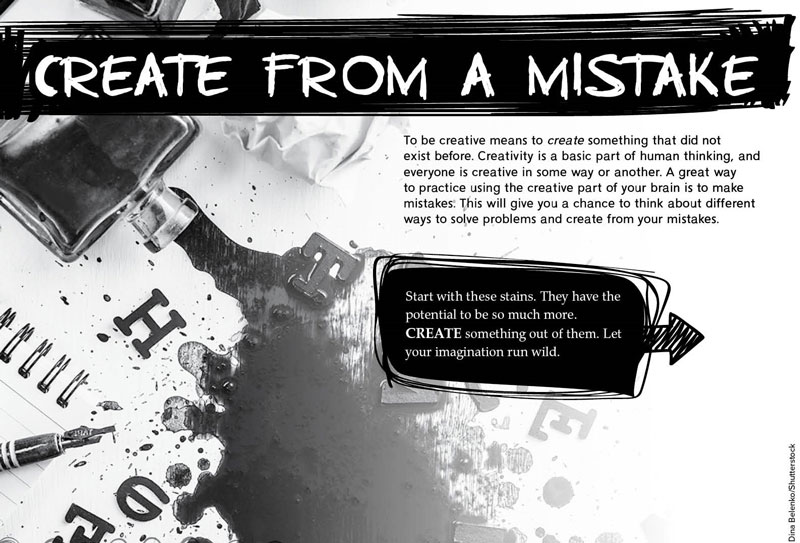
Find this activity in the student portfolio
Objective: Students will demonstrate creativity and think outside the box.
Estimated Duration: 20-25 minutes
Description: Creative thinking is the process of nurturing your imagination and allowing yourself to think outside of the box. Being able to train your mind to think creatively helps you invent, problem-solve, create, and communicate in fresh new ways.
It is important to develop creativity in the classroom because it will keep students engaged and it's something they will need later in school and when they enter the workforce. Creative thinkers are in high demand in the job market. Thinking creatively gives students the ability to embrace different points of view and listen to and consider other perspectives before making a decision.
This activity will get students to think outside the box by asking them to create something out of ink stains on their page. Their creation can be anything they imagine it to be! If there is time, students can compare their creations to see how many different versions people produced.
Teachable Moments: To help students have creativity and think outside the box:
- Share ways that you have been adaptable as a teacher or even outside of the classroom. Students will learn that having the ability to adapt is normal and then they will begin to emulate this.
- Provide ample time for students to solve problems or complete projects creatively. It takes time to think differently and outside of the box.
- Reverse the question/answer model in the classroom. Instead of asking questions to which there is a correct answer, ask students to create the problem.
- Play music in the classroom. Allow students to pick the music when they are working on projects. Music can create a different atmosphere and promote creative thinking all on its own.
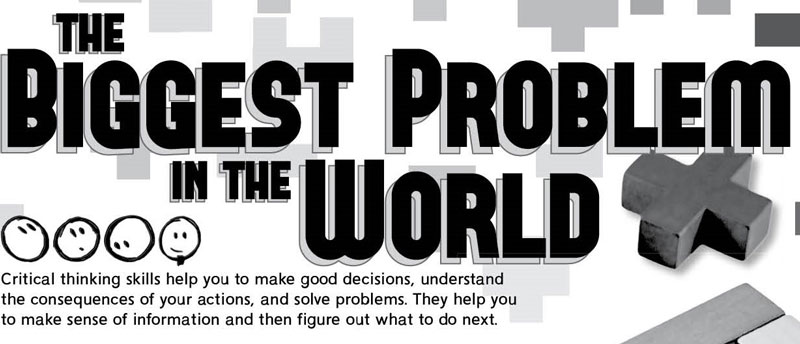
Find this activity in the student portfolio
Objective: Students will recognize the importance of critical thinking skills.
Estimated Duration: 20-25 minutes
Description: Critical thinking is about knowing how to think, not what to think. Critical thinking skills are important for students to help them think clearly, rationally, and independently.
We use critical thinking skills every day. They help us make good decisions, understand the consequences of our actions, and solve problems. Critical thinking helps with formulating your own opinions and drawing your own conclusions regardless of outside influences. It’s about using the process of analysis and seeing connections between ideas.
This activity will have students use their critical thinking skills by asking them what they think is the biggest problem in our world today. Then, they are asked how they would solve it if they had everything they needed, and anything was possible.
Teachable Moments: There are many ways to help students recognize the importance of critical thinking skills:
- Ask a lot of open-ended questions. This will give students a chance to apply what they have learned and build on prior knowledge.
- Encourage decision-making as much as possible. This will allow students to apply what they've learned to different situations, come up with a variety of solutions, then decide which ideas work best.
- Provide opportunities for group projects where students can expand their thinking.
- Allow opportunities in class to connect different ideas and to brainstorm.
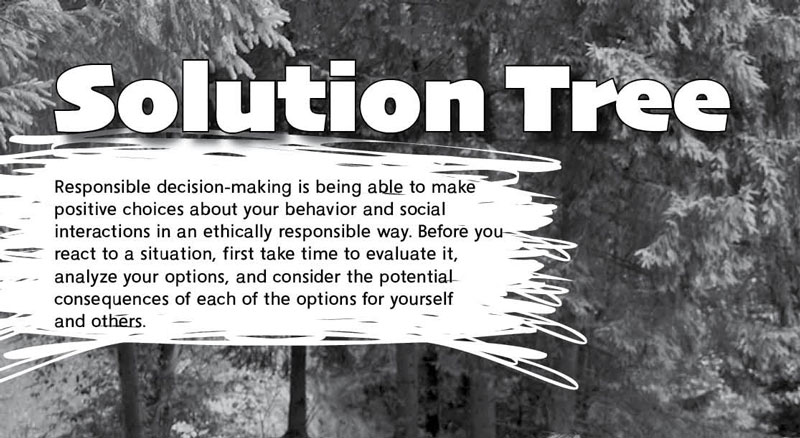
Find this activity in the student portfolio
Objective: Students will be able to understand the importance of making positive choices for personal behavior and social interactions.
Estimated Duration: 20 minutes
Description: Learning how to be a decision-maker is a lifelong skill, so it is important that students understand how to make good decisions. Good decisions are kind, safe, healthy, and make yourself and others proud.
Students need to understand that some choices they make will be more challenging than others because they have a big impact on their life. Meaning it could affect them for a length of time after the choice is made. It's important to help students learn to think carefully before they make a difficult choice. To stop and ask themselves if the choice they are making is the right thing to do.
This activity will help students understand how to work out real-life problems using a solution tree.
Teachable Moments: To help students make good choices:
- Model and role play real-life scenarios with students. Let them see how you make good choices for yourself based on the consequences.
- Provide students with choices for completing an assignment (e.g., draw a picture instead of writing about it, allow students to use technology, etc.)
- Play games like “What If...” to help students talk about how to make good choices during challenging moments.
- Ask students to write reflections about choices they have made that they want to go back to and change. What would they say or do differently? Why?
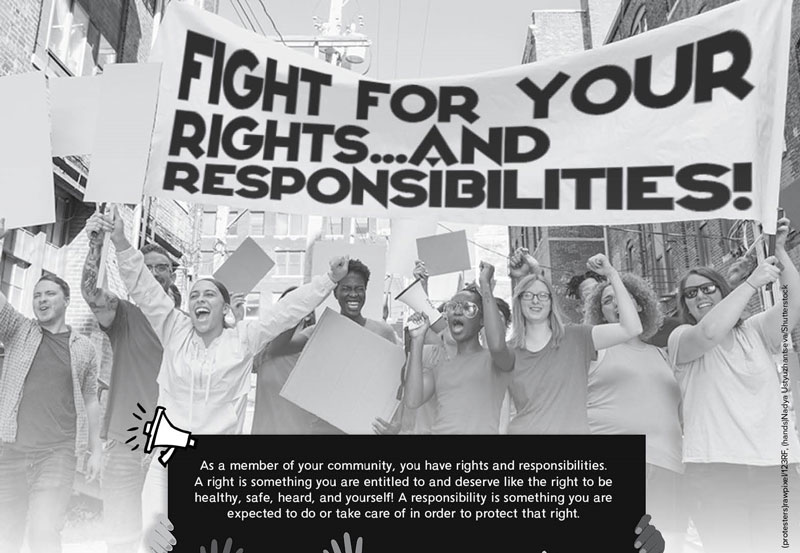
Find this activity in the student portfolio
Objective: Students will understand the difference between having rights and being responsible.
Estimated Duration: 20 minutes
Description: As a member of the community, we all have rights and responsibilities. A right is something you are entitled to and deserve like the right to be healthy, safe, heard, and yourself!
A responsibility is something you are expected to do or take care of to protect that right. Teaching students the difference between their rights and responsibilities will help them to become better members of their communities.
This activity will help students think about their role in their community. They will write a list of rights they have and a corresponding responsibility for that right.
Teachable Moments: To help students be responsible:
- Create a classroom Bill of Rights. Discuss the responsibilities each student has to uphold and protect their rights. Then, draft a set of rules or class laws that protect students’ rights.
- Model responsibility and talk about it. Talk about what rights are important to you and how you take initiative to protect them.
- Organize a common good day. Divide students into groups to manage different events and activities. Remind students that as community members they are responsible for maintaining their community and working for the common good.
Foldable®: If...Then Moments
Estimated Duration: 25-30 minutes

- Cut along the outside solid black lines of the Next time I will… One-Tab Foldable.
- Fold along the dotted line on the right edge of the rectangle to form an anchor tab.
- Glue the folded tab on top of the gray area in the student book that says: Glue anchor tab here: Next time I will... This added tab will cover half of the table printed in the student book.
- Over a period of time, students record three situations or problems that they experience and they note how they dealt with each in the My Decision box in the table.
- Over time, students analyze the consequences of their decisions. They respond on top of the Next time I will… Foldable column. This is where students can confirm that they made the right decision and would not change anything in the future, or they can report what they would do differently to achieve a more positive outcome the next time they experienced the same or a similar situation.
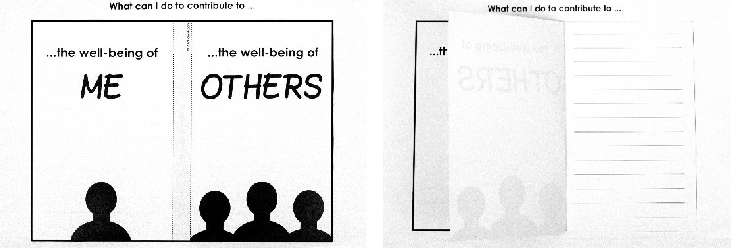
- Cut along the outside solid black lines of the large rectangular foldable.
- Fold along the two dotted lines in the middle of the rectangle. Fold so the dots are visible along the top of each fold. Refold along the same two-fold lines so the tab moves up and down easily.
- Glue the folded center anchor tab on top of the gray area in the student book that says: Glue anchor tab here.
- Under the tabs, students record things that they can do to contribute to the well-being of themselves and the well-being of others. Some students might draw pictures on the back of the tabs to illustrate their thoughts. For example, a student might draw a picture of them riding a bike,
participating in sports, listening to music, or reading a book.
Why is it important to think about ourselves AND others? What happens if someone only thinks of themselves? What happens if someone only thinks of others? Just as this Foldable is balanced along the central strip, we need to balance the decisions we make to promote well-being.
Go to other SEL competencies in this book (Intermediate 2 - Grades 5–6):
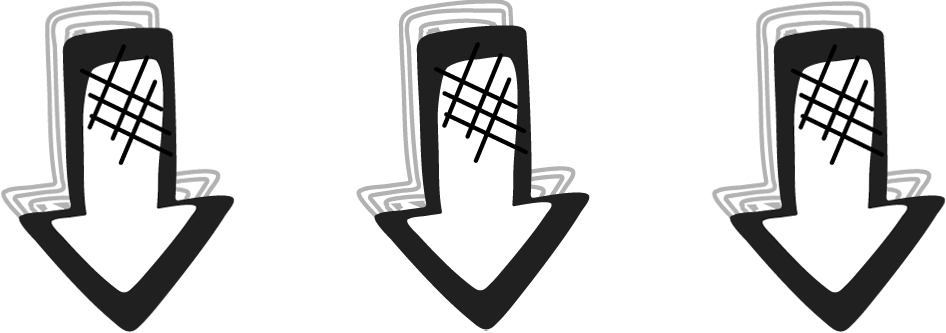
The teaching suggestions only work in accompaniment with the student portfolio, which has all the activity pages.
The teaching suggestions here are also available within a PDF of the entire teacher's manual.